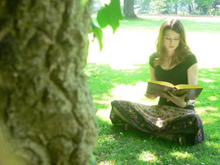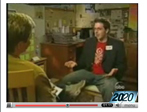
 Have you ever bought a book, read it, then threw it on your shelf and never thought about it again?
Have you ever bought a book, read it, then threw it on your shelf and never thought about it again?
Yeah. Me too.
It’s OK. Everyone’s done it before.
SO, HERE’S THE CHALLENGE: how do you read a book … effectively?
ANSWER: by using three different pairs of eyes.
First, your Superficial Eyes.
They don’t require much. All you have to do is, um, read the book!
You don’t need to read every word.
You don’t need to devour every page.
You don’t need to understand every concept.
Just get the key ideas. Figure out the ONE thing the author is trying to get across to you. And when you’re done, think (and rethink) about how it applies to your life.
That’s it. Pretty cut and dry.
Second comes your Student Eyes.
They require more of you. Namely, learning how to become a better writer yourself.
Now, it’s possible you’re thinking, “Yeah, but I’m not a writer! Who cares?”
Wrong-o, Shakespeare! Everyone is a writer. Whether you like it or not, whether you know it or not. Writing is the basis of all wealth.
For that reason, use your Student Eyes to observe the author’s writing style, vocabulary, page structure, sentence variation, and of course, unique voice.
Then, think about your own writing style.
ASK YOURSELF: How could I make my writing more effective, persuasive and creative?
Pick out little things and trends you noticed from other authors and adapt them to your own writing.
NOTE: that doesn’t mean copy! That means be inspired by someone else’s unique style to develop one of your own.
Lastly, use your Creative Eyes.
They require the most out of you. See, while you’re reading, you also need to watch, listen, associate, brainstorm and create related ideas of your own.
For example, let’s say you read a book in which the author says something powerful like, “The future is your property.” (Dan Sullivan actually says that in his awesome new book.)
Here’s how to use your Creative Eyes to “pluck” this scenario:
1. Stop reading.
2. Highlight or underline the key passage.
3. Put the book down.
4. Make a list of all the reasons, examples, ideas and stories that come to mind when you apply that idea to your own life.
5. Save that document in its own folder.
6. Come back to it later and expand on what you read.
That’s called Plucking. And it only works with the help of your Creative Eyes.
HOW I KNOW THIS: I’ve been writing books, articles, speeches and training materials for about five years now. And I can attribute HUNDREDS of ideas, chapters, articles and modules these very three principles.
PROMISE: they WILL work for you! And if you to begin reading books with Superficial, Student AND Creative Eye, you’ll speed up your learning curve faster than you can say supercalifragilisticexpialidocious.
Man, that really IS a long word.
LET ME ASK YA THIS…
How do you read books?
LET ME SUGGEST THIS…
Share your best techniques here!
* * * *
Scott Ginsberg
That Guy with the Nametag
www.hellomynameisscott.com
 Are you the luckiest person you know?
Are you the luckiest person you know?
Watch Scott’s interview on 20/20!
add to del.icio.us * digg it! * email this post
